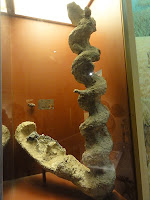 |
| Palaeocastor sp. |
Palaeocastor is one of these ancestors. This 1ft long critter lived in the Oligocene around 25 million years ago in North America. They didn't have the big paddle tail that our modern Beavers do, nor did they spend as much time in the water.
Interestingly, the burrows of Palaeocastor were discovered long before the fossils. Unlike modern Beavers, Palaeocastor did not build dens out of sticks and mud. Instead, they constructed strange, corkscrewed burrows... by digging with their teeth! Preserved remains of these burrows have been found, and are called "devil's corkscrews." It actually took some time for science to figure out what those strange structures were!
 |
| A fossilized "devil's corkscrew" |
Status : Extinct for 25 million years
Location : North America
Size : Body Length around 1ft (30cm)
Classification : Phylum : Chordata -- Class : Mammalia -- Order : Rodentia
Family : Castoridae -- Genus : †Palaeocastor
Family : Castoridae -- Genus : †Palaeocastor
Comments
Post a Comment